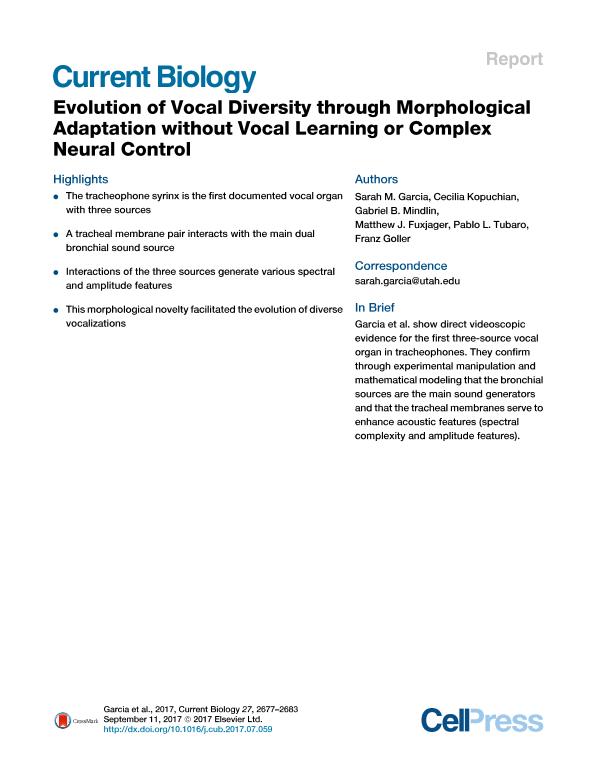Mostrar el registro sencillo del ítem
dc.contributor.author
Garcia, Sarah
dc.contributor.author
Kopuchian, Cecilia

dc.contributor.author
Mindlin, Bernardo Gabriel

dc.contributor.author
Fuxjager, Matthew
dc.contributor.author
Tubaro, Pablo Luis

dc.contributor.author
Goller, Franz

dc.date.available
2023-01-03T18:14:42Z
dc.date.issued
2017-09
dc.identifier.citation
Garcia, Sarah; Kopuchian, Cecilia; Mindlin, Bernardo Gabriel; Fuxjager, Matthew; Tubaro, Pablo Luis; et al.; Evolution of vocal diversity arises through morphological adaptation in the absence of vocal learning and complex neural control; Cell Press; Current Biology; 27; 17; 9-2017; 2677-2683
dc.identifier.issn
0960-9822
dc.identifier.uri
http://hdl.handle.net/11336/183219
dc.description.abstract
The evolution of complex behavior is driven by the interplay of morphological specializations and neuromuscular control mechanisms [1–3], and it is often difficult to tease apart their respective contributions. Avian vocal learning and associated neural adaptations are thought to have played a major role in bird diversification [4–8], whereas functional significance of substantial morphological diversity of the vocal organ remains largely unexplored. Within the most species-rich order, Passeriformes, “tracheophones” are a suboscine group that, unlike their oscine sister taxon, does not exhibit vocal learning [9] and is thought to phonate with tracheal membranes [10, 11] instead of the two independent sources found in other passerines [12–14]. Here we show tracheophones possess three sound sources, two oscine-like labial pairs and the unique tracheal membranes, which collectively represent the largest described number of sound sources for a vocal organ. Birds with experimentally disabled tracheal membranes were still able to phonate. Instead of the main sound source, the tracheal membranes constitute a morphological specialization, which, through interaction with bronchial labia, contributes to different acoustic features such as spectral complexity, amplitude modulation, and enhanced sound amplitude. In contrast, these same features arise in oscines from neuromuscular control of two labial sources [15–17]. These findings are supported by a modeling approach and provide a clear example for how a morphological adaptation of the tracheophone vocal organ can generate specific, complex sound features. Morphological specialization therefore constitutes an alternative path in the evolution of acoustic diversity to that of oscine vocal learning and complex neural control.
dc.format
application/pdf
dc.language.iso
eng
dc.publisher
Cell Press

dc.rights
info:eu-repo/semantics/openAccess
dc.rights.uri
https://creativecommons.org/licenses/by-nc-nd/2.5/ar/
dc.subject
FUNCTIONAL MORPHOLOGY
dc.subject
SUBOSCINE
dc.subject
SYRINX
dc.subject
TRACHEOPHONE
dc.subject.classification
Zoología, Ornitología, Entomología, Etología

dc.subject.classification
Ciencias Biológicas

dc.subject.classification
CIENCIAS NATURALES Y EXACTAS

dc.title
Evolution of vocal diversity arises through morphological adaptation in the absence of vocal learning and complex neural control
dc.type
info:eu-repo/semantics/article
dc.type
info:ar-repo/semantics/artículo
dc.type
info:eu-repo/semantics/publishedVersion
dc.date.updated
2023-01-03T14:33:07Z
dc.journal.volume
27
dc.journal.number
17
dc.journal.pagination
2677-2683
dc.journal.pais
Estados Unidos

dc.description.fil
Fil: Garcia, Sarah. University of Utah; Estados Unidos
dc.description.fil
Fil: Kopuchian, Cecilia. Consejo Nacional de Investigaciones Científicas y Técnicas. Centro Científico Tecnológico Conicet - Nordeste. Centro de Ecología Aplicada del Litoral. Universidad Nacional del Nordeste. Centro de Ecología Aplicada del Litoral; Argentina. Universidad Nacional de La Plata. Facultad de Ciencias Naturales y Museo. División Zoología de Vertebrados. Sección Ornitología; Argentina
dc.description.fil
Fil: Mindlin, Bernardo Gabriel. Consejo Nacional de Investigaciones Científicas y Técnicas; Argentina. Universidad de Buenos Aires. Facultad de Ciencias Exactas y Naturales. Departamento de Física; Argentina
dc.description.fil
Fil: Fuxjager, Matthew. University Wake Forest; Estados Unidos
dc.description.fil
Fil: Tubaro, Pablo Luis. Consejo Nacional de Investigaciones Científicas y Técnicas. Oficina de Coordinación Administrativa Parque Centenario. Museo Argentino de Ciencias Naturales "Bernardino Rivadavia"; Argentina
dc.description.fil
Fil: Goller, Franz. University of Utah; Estados Unidos
dc.journal.title
Current Biology

dc.relation.alternativeid
info:eu-repo/semantics/altIdentifier/url/https://www.sciencedirect.com/science/article/pii/S0960982217309636
dc.relation.alternativeid
info:eu-repo/semantics/altIdentifier/doi/http://dx.doi.org/10.1016/j.cub.2017.07.059
Archivos asociados
